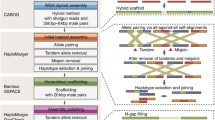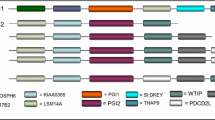Abstract
Vertebrate genomes are mosaics of isochores, defined as long (>100 kb) regions with relatively homogeneous within-region base composition. Birds and mammals have more GC-rich isochores than amphibians and fish, and the GC-rich isochores of birds and mammals have been suggested to be an adaptation to homeothermy. If this hypothesis is correct, all poikilothermic (cold-blooded) vertebrates, including the nonavian reptiles, are expected to lack a GC-rich isochore structure. Previous studies using various methods to examine isochore structure in crocodilians, turtles, and squamates have led to different conclusions. We collected more than 6000 expressed sequence tags (ESTs) from the American alligator to overcome sample size limitations suggested to be the fundamental problem in the previous reptilian studies. The alligator ESTs were assembled and aligned with their human, mouse, chicken, and western clawed frog orthologs, resulting in 366 alignments. Analyses of third-codon-position GC content provided conclusive evidence that the poikilothermic alligator has GC-rich isochores, like homeothermic birds and mammals. We placed these results in a theoretical framework able to unify available models of isochore evolution. The data collected for this study allowed us to reject the models that explain the evolution of GC content using changes in body temperature associated with the transition from poikilothermy to homeothermy. Falsification of these models places fundamental constraints upon the plausible pathways for the evolution of isochores.





Similar content being viewed by others

References
Altschul SF, Madden TL, Schaffer AA, Zhang J, Zhang Z, Miller W, Lipman DJ (1997) Gapped BLAST and PSI-BLAST: a new generation of protein database search programs. Nucleic Acids Res 25:3389–3402
Benton MJ, Donoghue PC (2007) Paleontological evidence to date the tree of life. Mol Biol Evol 24:26–53
Bernardi G (1995) The human genome: organization and evolutionary history. Annu Rev Genet 29:445–447
Bernardi G (2000) Isochores and the evolutionary genomics of vertebrates. Gene 241:3–17
Bernardi G, Bernardi G (1991) Compositional properties of nuclear genes from cold-blooded vertebrates. J Mol Evol 33:57–67
Bernardi G, Hughes S, Mouchiroud D (1997) The major compositional transitions in the vertebrate genome. J Mol Evol 44:44–51
Birney E, Andrews D, Caccamo M, et al. (2006) Ensembl 2006. Nucleic Acids Res 34:556–561
Cacciò S, Zoubak S, D’Onofrio G, Bernardi G (1995) Nonrandom frequency patterns of synonymous substitutions in homologous mammalian genes. J Mol Evol 40:280–292
Cacciò S, Jabbari K, Matassi G, Guermonprez F, Desgres J, Bernardi G (1997) Methylation patterns in the isochores of vertebrate genomes. Gene 205:119–124
Chenna R, Sugawara H, Koike T, Lopez R, Gibson TJ, Higgins DG, Thompson JD (2003) Multiple sequence alignment with the Clustal series of programs. Nucleic Acids Res 31:3497–3500
Duret L, Semon M, Piganeau G, Mouchiroud D, Galtier N (2002) Vanishing GC-rich isochores in mammalian genomes. Genetics 162:1837–1847
Eyre-Walker A (1992) Evidence that both G + C rich and G + C poor isochores are replicated early and late in the cell cycle. Nucleic Acids Res 20:1497–1501
Eyre-Walker A (1993) Recombination and mammalian genome evolution. Proc Biol Sci 252:237–243
Eyre-Walker A (1999) Evidence of selection on silent site base composition in mammals: potential implications for the evolution of isochores and junk DNA. Genetics 152:675–683
Eyre-Walker A, Hurst LD (2001) The evolution of isochores. Nat Rev Genet 2:549–555
Fryxell KJ, Zuckerkandl E (2000) Cytosine deamination plays a primary role in the evolution of mammalian isochores. Mol Biol Evol 17:1371–1383
Galtier N, Mouchiroud D (1998) Isochore evolution in mammals: a human-like ancestral structure. Genetics 150:1577–1584
Galtier N, Piganeau G, Mouchiroud D, Duret L (2001) GC-content evolution in mammalian genomes: the biased gene conversion hypothesis. Genetics 159:907–911
Hackenberg M, Bernaola-Galvan P, Carpena P, Oliver JL (2005) The biased distribution of Alus in human isochores might be driven by recombination. J Mol Evol 60:365–377
Hamada K, Horiike T, Kanaya S, Nakamura H, Ota H, Yatogo T, Okada K, Nakamura H, Shinozawa T (2002) Changes in body temperature pattern in vertebrates do not influence the codon usages of α-globin genes. Genes Genet Syst 77:197–207
Hillenius WJ, Ruben JA (2004) Getting warmer, getting colder: Reconstructing crocodylomorph physiology. Physiol Biochem Zool 77:1068–1072
Hughes S, Zelus D, Mouchiroud D (1999) Warm-blooded isochore structure in Nile crocodile and turtle. Mol Biol Evol 16:1521–1527
Isobe T, Feigelson ED, Akritas MG, Babu GJ (1990) Linear regression in astronomy. Astrophys J 364:104–113
Jabbari K, Bernardi G (2004) Body temperature and evolutionary genomics of vertebrates: a lesson from the genomes of Takifugu rubripes and Tetraodon nigroviridis. Gene 333:179–188
Li WH (1997) Molecular Evolution. Sinauer Associates, Sunderland, MA, pp 407–411
Liang F, Holt I, Pertea G, Karamycheva S, Salzberg SL, Quackenbush J (2000) An optimized protocol for analysis of EST sequences. Nucleic Acids Res 28:3657–3665
Maddison D, Maddison W (2002) MacClade. Sinauer Associates, Sunderland, MA
Musto H, Romero H, Zavala A, Bernardi G (1999) Compositional correlations in the chicken genome. J Mol Evol 49:325–329
Saccone S, Cacciò S, Perani P, Andreozzi L, Rapisarda A, Motta S, Bernardi G (1997) Compositional mapping of mouse chromosomes and identification of the gene-rich regions. Chromosome Res 5:293–300
Seebacher F, Shine R (2004) Evaluating thermoregulation in reptiles: the fallacy of the inappropriately applied method. Physiol Biochem Zool 77:688–695
Seebacher F, Grigg GC, Beard LA (1999) Crocodiles as dinosaurs: behavioural thermoregulation in very large ectotherms leads to high and stable body temperatures. J Exp Biol 202:77–86
Seymour RS, Bennett-Stamper CL, Johnston SD, Carrier DR, Grigg GC (2004) Evidence for endothermic ancestors of crocodiles at the stem of archosaur evolution. Physiol Biochem Zool 77:1051–1067
Swofford D (1998) PAUP*: phylogenetic analysis using parsimony (*and other methods), ver. 4. Sinauer Associates, Sunderland, MA
Varriale A, Bernardi G (2006) DNA methylation in reptiles. Gene 385:122–127
Webster MT, Axelsson E, Ellegren H (2006) Strong regional biases in nucleotide substitution in the chicken genome. Mol Biol Evol 23:1203–1216
Wolfe KH, Sharp PM, Li WH (1989) Mutation rates differ among regions of mammalian genome. Nature 337:283–285
Zhang CT, Wang J, Zhang R (2001) A novel method to calculate the G+C content of genomic DNA sequences. J Biomol Struct Dyn 19:333–341
Zoubak S, Clay O, Bernardi G (1996) The gene distribution of the human genome. Gene 174:95–102
Acknowledgments
We are grateful to the members of the Braun-Kimball lab group for helpful discussion and to Holly Kindsvater and Mike McCoy for help with R and statistical advice. This work was supported in part by grants to Y.K. and T.I. (Grant-in-Aid for Scientific Research from the Ministry of Education, Science, Sports and Culture of Japan and grants from the Ministry of Environment, Japan) and to E.L.B. and L.J.G. (University of Florida Opportunity Fund).
Author information
Authors and Affiliations
Corresponding author
Additional information
Reviewing Editor: Dr. Nicolas Galtier
Electronic supplementary material
Rights and permissions
About this article
Cite this article
Chojnowski, J.L., Franklin, J., Katsu, Y. et al. Patterns of Vertebrate Isochore Evolution Revealed by Comparison of Expressed Mammalian, Avian, and Crocodilian Genes. J Mol Evol 65, 259–266 (2007). https://doi.org/10.1007/s00239-007-9003-2
Received:
Accepted:
Published:
Issue Date:
DOI: https://doi.org/10.1007/s00239-007-9003-2



